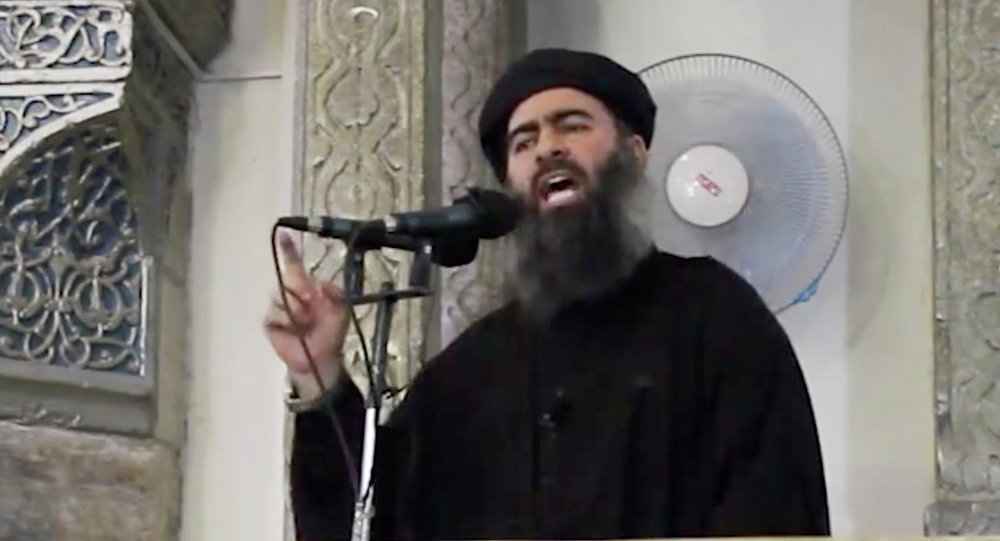Anatomy of a raid, and how not everyone is happy with details
Special operations and intelligence veterans fear that President Donald Trump’s announcement of the death of ISIS leader Abu Bakr al-Baghdadi could imperil future raids as he revealed a slew of sensitive details about the secret military operation.
Photo: File/AP

By IAR Desk
U.S. President Donald Trump on Sunday announced that Abu Bakr al-Baghdadi, leader of violent jihadist group Islamic State, died during an overnight raid led by U.S. military forces in Syria, Reuters reported.
Here is a description of the raid according to Trump, who went into unusual detail during a national address broadcast from the White House., as reported by Reuters:* The United States began to receive intelligence on the whereabouts of Baghdadi around a month ago, including some “helpful” information from the Kurds, said Trump. U.S. intelligence officials were able to “scope out” his exact location two weeks ago, while Trump himself became aware of the planned raid three days ago. As part of the plan, the United States had to secure permission from Russia, Iraq and Turkey to fly over their airspace, according to Trump and National Security Adviser Robert O’Brien. Trump said the White House did not disclose the nature of the operation to Russia, but told Russian officials they would “like” it.
* On Saturday, Trump arrived back at the White House at around 4:30 p.m. local time (10:30pm in Syria) after a round of golf in Virginia, according to his official schedule. At around 5 pm, he gathered in the White House Situation Room with Vice President Mike Pence, Defense Secretary Mark Esper, national security adviser Robert O’Brien, and other intelligence officials. They watched the raid unfold live “as if you were watching a movie,” said Trump.
* Moments after they gathered, U.S. military personnel and military dogs lifted-off in eight helicopters from an unidentified military base in the Middle East, according to Trump. The personnel came from the Delta Force, one of the U.S. special units mainly focused on counter-terrorism and often deployed to capture high-value targets. A U.S. official told Reuters the operation was staged from an airbase in western Iraq. The on-the-ground operation in the Idlib region of Syria was supported by military aircraft and ships, said Trump. The operatives were also equipped with a military robot but did not ultimately use it.
* Upon approaching Baghdadi’s compound, the helicopters came under gunfire but U.S. forces were able to quickly suppress the assault and land safely. Believing the main compound door to be booby trapped, they entered in just seconds by blasting through the wall, said Trump. “We were getting full reports on a minute-by-minute basis,” he added.
* U.S. forces quickly cleared the compound “with people either surrendering or being shot and killed,” said Trump. Eleven children were removed, uninjured, and taken into care by a third party whom the president declined to name. U.S. soldiers captured and later imprisoned several Islamic State fighters.
* Baghdadi fled into a subterranean area of the complex and into a tunnel, dragging three of his young children with him. Esper told CNN’s Jake Tapper on Sunday that U.S. forces called for Baghdadi to surrender but the world’s most wanted man refused. Chased by the dogs and confronted by a dead end, Baghdadi – “whimpering and crying and screaming,” according to Trump – ignited his suicide vest, killing himself and his children and causing the tunnel to collapse. No military personnel were hurt although one dog was badly injured.
* With Baghdadi’s body “mutilated by the blasts,” U.S. forces used a DNA test onsite to confirm his identity in around 15 minutes. “The test results gave certain, immediate and totally positive identification. It was him,” said Trump. Speaking on NBC News’ Meet The Press with Chuck Todd on Sunday, O’Brien said: “We were in the Situation Room. And the commander of the mission called and said, ‘100% confidence, jackpot.”
* The soldiers proceeded to search the compound, taking “highly sensitive material” including information on Islamic State’s origins and its future plans. In total, U.S. forces were in the compound for around two hours before flying back out via the same route they flew in.
* Baghdadi’s body will be “disposed of properly,” O’Brien said, adding that he expected it to be the same protocol followed in 2011 for Osama bin Laden. The al Qaeda leader was buried at sea after U.S. officials consulted with experts in Islamic law and ritual.
However, special operations and intelligence veterans fear that President Donald Trump’s announcement of the death of ISIS leader Abu Bakr al-Baghdadi could imperil future raids as he revealed a slew of sensitive details about the secret military operation.
“I always get a little bit nervous when people without knowledge of operations start describing operations,” said Michael Nagata, a retired Army lieutenant general who was the senior special operations commander in the Middle East during the early stages of the anti-ISIS campaign, speaking to Politico. “It’s a good story, and I can understand the impulse to tell a good story. Telling it can have positive benefits. But the benefits are unpredictable and marginal, whereas the harm could be more substantial.”
Meanwhile, the Russian Ministry of Defence has announced that it does not have reliable information regarding the US operation in Idlib which allegedly resulted in the death of terrorist leader Abu Bakr al-Baghdadi.
President Trump had said that the raid and capture of Baghdadi had been carried out in cooperation with a number of countries, including Russia.
However, Russia’s Defence Ministry spokesperson Maj. Gen Igor Konashenkov said “The Russian Defence Ministry has no reliable information about US servicemen conduction an operation to ‘yet another’ elimination of the former Daesh leader Abu Bark al-Baghdadi in the Turkish-controlled part of the Idlib deescalation zone”, reported Sputnik News Agency.
– With inputs by agencies